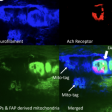Transplantation of muscle stem cells (FAPs) stimulates rotator cuff muscle to regenerate more quickly with increased muscle quality and better muscle function. (Photo Credit: Feeley-Liu Lab at UCSF)
Dr. Brian Feeley and Dr. Xuhui Liu co-direct the MITO (Muscle Injury and Translational Orthopedic) research lab. The lab performs research on muscle tissue quality and its impact on common problems, including rotator cuff tears, knee pain, limb immobilization, joint contractures, and low back pain. They collaborate with Hubert Kim, MD and other researchers at the UCSF/VA Mission Bay campus to develop models for studying the molecular and cellular mechanisms responsible for muscle degeneration—and regeneration. This stem cell research is funded by CIRM, the NIH, the VA, UCSF, and private donations. Members of the lab have won awards and research grants from the American Academy of Orthopaedic Surgeons (AAOS), the American Orthopaedic Society for Sports Medicine (AOSSM), and the Orthopaedic Research Society (ORS). Most recently, the research team has won the ASES Neer Award (2020), the AOSSM Excellence in Research Award (2021), ASES and OREF Resident Research Awards (2022, 2023) and the AOSSM Cabaud Award (2023). We strive for a collaborative, inclusive scientific environment that fosters the growth of scientists of all levels.
What we study
Cells within muscle can look like muscle or they can be fibrotic or fat. We see more fibrotic and fatty cells after injury and muscle breakdown (atrophy). As a result, for a long time doctors assumed that many of the non-muscle cells in muscle were a result of injury and were not helpful to the muscle. They also thought all fat cells in muscle were the same. In rotator cuff tissue, it was thought that the fat ‘infiltrated’ or ‘walked in’ from the surrounding tissue. Once any of these cells “infiltrated” the muscle, doctors believed, they stayed the same and didn’t have anything positive to give back to muscle. Using modern single-cell sequencing techniques (scRNASeq), we now know that individual cells can change their phenotype over time (cellular plasticity). Some stem cells act like blank slates that become different based on what’s going on around them. Certain cells (called fibroadipoprogenitors or FAPs), can turn into white fat, which may be energy stores for the muscle. They can also become cells that resemble brown fat or beige fat. As it turns out, FAPs have important roles in energy balance and may produce local growth factors, such as IGF-1, that promote a regenerative environment for muscle. In other words, with the right stimulus, these cells might be available to help muscle get healthy again. We are also exploring what these stimuli are, as well as other mechanisms that govern how these cells work. Please click on the Research tab above to learn more about how we’re investigating this.



